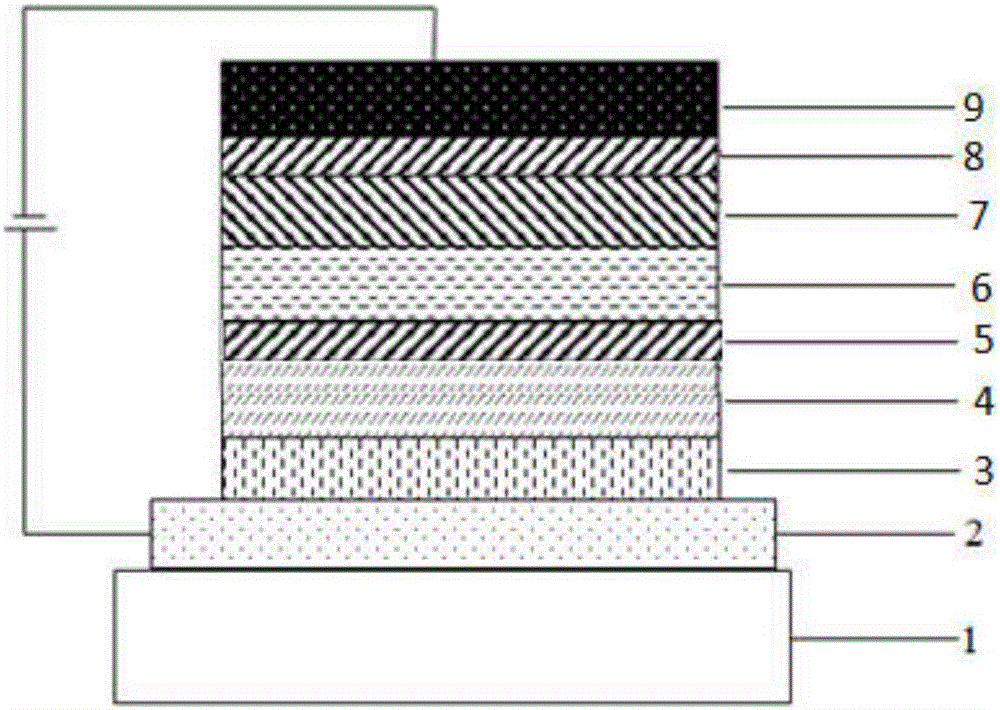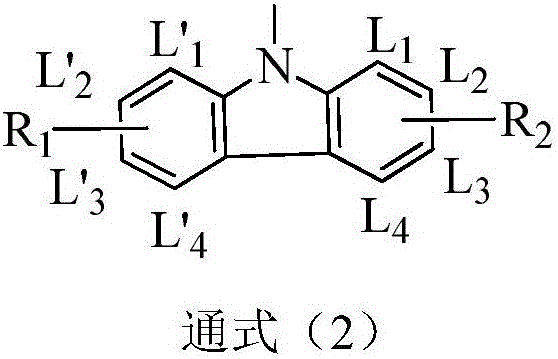Organic compounds using homobenzenes as core and application thereof in organic electroluminescent devices
An organic compound and organic technology, applied to the application of organic electroluminescent devices, in the field of organic compounds, can solve problems such as performance differences, achieve high film stability, improve current efficiency and life, and reduce efficiency roll-off effects
- Summary
- Abstract
- Description
- Claims
- Application Information
AI Technical Summary
Problems solved by technology
Method used
Image
Examples
Embodiment 1
[0051] Embodiment 1: the synthesis of intermediate I
[0052]
[0053] (1) Weigh 1,3,5-tribromobenzene and raw material U(Ar 1 -B(OH) 2 ), dissolved in a mixed solvent of toluene and ethanol with a volume ratio of 1.5 to 3.0:1; then add Na 2 CO 3 Aqueous solution, Pd(PPh 3 ) 4 ; Under an inert atmosphere, stir the above mixed solution at 95-100°C for 10-24 hours, then cool to room temperature, filter the reaction solution, spin the filtrate, and pass through a silica gel column to obtain intermediate V; the raw material U The molar ratio to 1,3,5-tribromobenzene is 1:1.5~3.0; Pd(PPh 3 ) 4 The molar ratio to raw material U is 0.006~0.02:1, Na 2 CO 3 The molar ratio to raw material U is 2.0-3.0:1.
[0054] (2) Weigh intermediate V and raw material W, and dissolve them in a mixed solvent of toluene and ethanol with a volume ratio of 1.5 to 3.0:1; then add Na 2 CO 3 Aqueous solution, Pd(PPh 3 ) 4 ; Under an inert atmosphere, stir the above mixed solution at 95-100°...
Embodiment 2
[0065] Embodiment 2: the synthesis of compound 5:
[0066]
[0067] In a 250ml three-necked flask, under a nitrogen atmosphere, add 0.01mol of intermediate A1, 0.015mol of raw material B1, 0.03mol of sodium tert-butoxide, 1×10 -4 mol Pd 2 (dba) 3 , 1×10 -4 mol of tri-tert-butylphosphine, 150ml of toluene, heated to reflux for 24 hours, sampling plate, the reaction was complete; naturally cooled, filtered, the filtrate was rotary evaporated, and passed through a silica gel column to obtain the target product with a purity of 98.8% and a yield of 72.3%.
[0068] Elemental analysis structure (molecular formula C 48 h 29 NO 2 ): theoretical value C, 88.46; H, 4.48; N, 2.15; O, 4.91; test value: C, 88.45; HPLC-MS: The theoretical molecular weight of the material is 651.22, and the measured molecular weight is 651.53.
Embodiment 3
[0069] Embodiment 3: the synthesis of compound 10:
[0070]
[0071] In a 250ml three-necked flask, add 0.01mol intermediate A2, 0.015mol raw material B1, 0.03mol sodium tert-butoxide, 1×10 -4 mol Pd 2 (dba) 3 , 1×10 -4 mol of tri-tert-butylphosphine, 150ml of toluene, heated to reflux for 24 hours, sampling point plate, the reaction was complete; naturally cooled, filtered, filtrate was rotary evaporated, passed through a silica gel column to obtain the target product with a purity of 98.9% and a yield of 71.8%.
[0072] Elemental analysis structure (molecular formula C 48 h 27 NO 3 ): theoretical value C, 86.60; H, 4.09; N, 2.10; O, 7.21; test value: C, 86.61; H, 4.07; N, 2.12; HPLC-MS: The theoretical molecular weight of the material is 665.20, and the measured molecular weight is 665.48.
PUM
| Property | Measurement | Unit |
|---|---|---|
| thickness | aaaaa | aaaaa |
| thickness | aaaaa | aaaaa |
Abstract
Description
Claims
Application Information
 Login to View More
Login to View More - R&D
- Intellectual Property
- Life Sciences
- Materials
- Tech Scout
- Unparalleled Data Quality
- Higher Quality Content
- 60% Fewer Hallucinations
Browse by: Latest US Patents, China's latest patents, Technical Efficacy Thesaurus, Application Domain, Technology Topic, Popular Technical Reports.
© 2025 PatSnap. All rights reserved.Legal|Privacy policy|Modern Slavery Act Transparency Statement|Sitemap|About US| Contact US: help@patsnap.com



